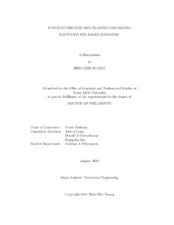| dc.description.abstract | Layer-by-Layer (LbL) assembly technique is a powerful approach to blend two or more materials to form new materials of thin films on any type of substrate, and the LbL film is called polyelectrolyte multilayers (PEMs). The assemblies are highly influenced by processing conditions and types of incorporated materials, and their morphology and chemical functionality can be controlled and tunable. The advantages allow people to design films with desired properties for a given application.
This study uses linear polyethyleneimine (LPEI) and poly(ethylene-co-methacrylic acid) (EMAA) ionomer as main materials. EMAA ionomer is a commercial material known as Surlyn having ethylene as the major component, and dissolved in THF at 65℃ but becomes a colloidal dispersion when temperature goes down to room temperature. Water soluble LPEI solution has a large and changeable range of ionization degree by adjusting the solution pH, which also changes chain conformation. Oppositely, the ionomer has a low content of charged carboxylic acid groups, only 1.62 mole %, resulting in energetically favorable aggregation of ionic species.
This study focuses on complexing the polymers having a drastically large difference in terms of ionization degree using LbL technique at a mixed THF-water solvent system. Via electrostatic interactions between LPEI and EMAA ionomers, the blends are successfully fabricated. Thermal, mechanical, and surface properties of the PEMs are investigated. For thermal properties, a new endothermic peak created in PEMs according to results of DSC overlaps with order-disorder transition peak and melting point of ionomer, resulting in an increase of latent energy. The interactions between the materials influence mechanical behavior; the PEMs exhibit higher stiffness and tensile strength, and are still tough. The most interesting and impressive performance of the blends is surface properties. Micro-sized holes and nano-scale structures (hierarchical morphology) found on the surfaces of LbL assemblies by SEM make the films very hydrophobic and superoleophilic to allow the films to separate water out from an oil-water emulsion. The film surfaces also show rose petal effect to pin water droplet of a high volume even though the surface is turn up
side down. The work is the first demonstrator to use EMAA ionomers as a material in the LbL system. Many basic properties of the new complex are investigated and characterized, and these results are believed to benefit the development of novel materials in the future. | en |


